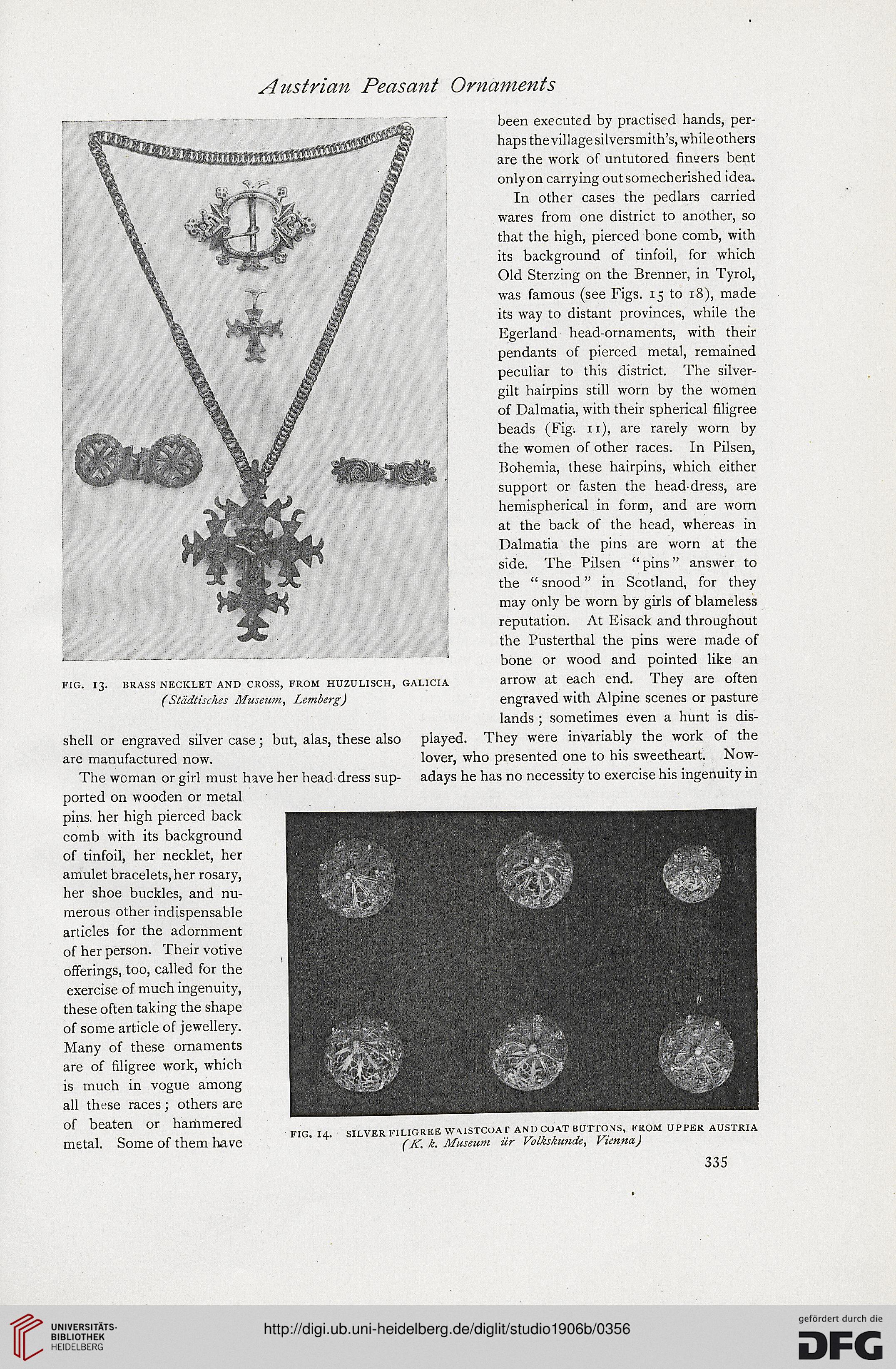Austrian Peasant Ornaments
FIG. 13. BRASS NECKLET AND CROSS, FROM HUZULISCH, GALICIA
(Stddtisches Museum, Lemberg)
shell or engraved silver case; but, alas, these also
are manufactured now.
The woman or girl must have her head dress sup-
ported on wooden or metal
pins, her high pierced back
comb with its background
of tinfoil, her necklet, her
amulet bracelets, her rosary,
her shoe buckles, and nu-
merous other indispensable
articles for the adornment
of her person. Their votive
offerings, too, called for the
exercise of much ingenuity,
these often taking the shape
of some article of jewellery.
Many of these ornaments
are of filigree work, which
is much in vogue among
all these races ; others are
of beaten or hammered
metal. Some of them have
been executed by practised hands, per-
haps the village silversmith’s, while others
are the work of untutored finvers bent
only on carrying outsomecherished idea.
In other cases the pedlars carried
wares from one district to another, so
that the high, pierced bone comb, with
its background of tinfoil, for which
Old Sterzing on the Brenner, in Tyrol,
was famous (see Figs. 15 to 18), made
its way to distant provinces, while the
Egerland head-ornaments, with their
pendants of pierced metal, remained
peculiar to this district. The silver-
gilt hairpins still worn by the women
of Dalmatia, with their spherical filigree
beads (Fig; x 1), are rarely worn by
the women of other races. In Pilsen,
Bohemia, these hairpins, which either
support or fasten the head dress, are
hemispherical in form, and are worn
at the back of the head, whereas in
Dalmatia the pins are worn at the
side. The Pilsen “ pins ” answer to
the “ snood ” in Scotland, for they
may only be worn by girls of blameless
reputation. At Eisack and throughout
the Pusterthal the pins were made of
bone or wood and pointed like an
arrow at each end. They are often
engraved with Alpine scenes or pasture
lands ; sometimes even a hunt is dis-
played. They were invariably the work of the
lover, who presented one to his sweetheart. Now-
adays he has no necessity to exercise his ingenuity in
fig. 14.
SILVER FILIGREE WAISTCOAT AND COAT BUTTONS, FROM UPPER AUSTRIA
(K. k. Museum iir Volkskunde, Vienna)
33S
FIG. 13. BRASS NECKLET AND CROSS, FROM HUZULISCH, GALICIA
(Stddtisches Museum, Lemberg)
shell or engraved silver case; but, alas, these also
are manufactured now.
The woman or girl must have her head dress sup-
ported on wooden or metal
pins, her high pierced back
comb with its background
of tinfoil, her necklet, her
amulet bracelets, her rosary,
her shoe buckles, and nu-
merous other indispensable
articles for the adornment
of her person. Their votive
offerings, too, called for the
exercise of much ingenuity,
these often taking the shape
of some article of jewellery.
Many of these ornaments
are of filigree work, which
is much in vogue among
all these races ; others are
of beaten or hammered
metal. Some of them have
been executed by practised hands, per-
haps the village silversmith’s, while others
are the work of untutored finvers bent
only on carrying outsomecherished idea.
In other cases the pedlars carried
wares from one district to another, so
that the high, pierced bone comb, with
its background of tinfoil, for which
Old Sterzing on the Brenner, in Tyrol,
was famous (see Figs. 15 to 18), made
its way to distant provinces, while the
Egerland head-ornaments, with their
pendants of pierced metal, remained
peculiar to this district. The silver-
gilt hairpins still worn by the women
of Dalmatia, with their spherical filigree
beads (Fig; x 1), are rarely worn by
the women of other races. In Pilsen,
Bohemia, these hairpins, which either
support or fasten the head dress, are
hemispherical in form, and are worn
at the back of the head, whereas in
Dalmatia the pins are worn at the
side. The Pilsen “ pins ” answer to
the “ snood ” in Scotland, for they
may only be worn by girls of blameless
reputation. At Eisack and throughout
the Pusterthal the pins were made of
bone or wood and pointed like an
arrow at each end. They are often
engraved with Alpine scenes or pasture
lands ; sometimes even a hunt is dis-
played. They were invariably the work of the
lover, who presented one to his sweetheart. Now-
adays he has no necessity to exercise his ingenuity in
fig. 14.
SILVER FILIGREE WAISTCOAT AND COAT BUTTONS, FROM UPPER AUSTRIA
(K. k. Museum iir Volkskunde, Vienna)
33S




